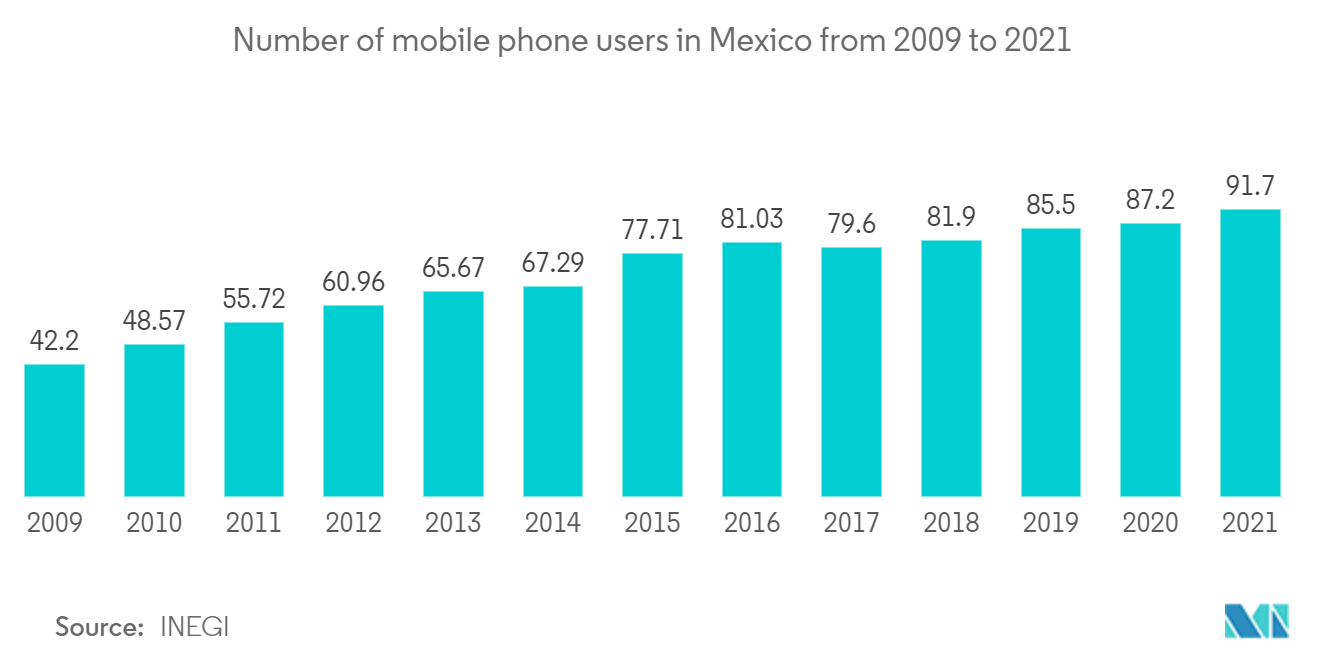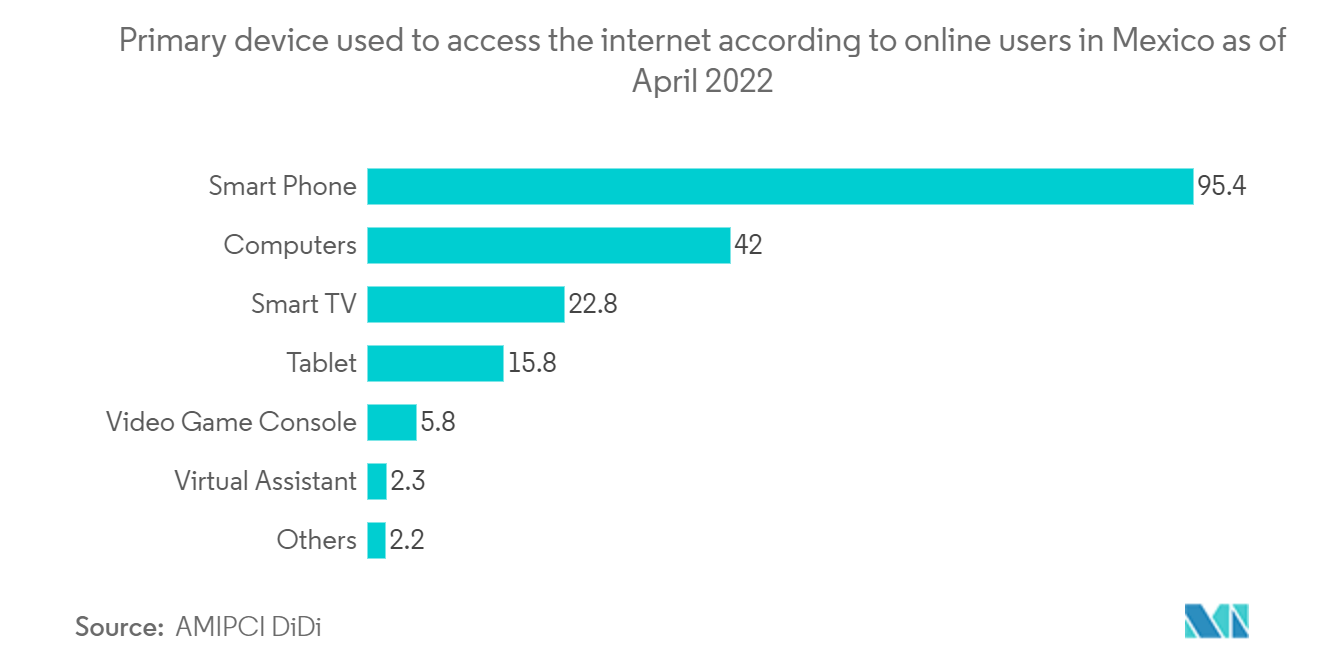Market Trends of Mexico Telecom Industry
This section covers the major market trends shaping the Mexico Telecom Market according to our research experts:
Increased Use of Mobile Phones
- In Mexico, the prevalence and use of mobile services have significantly accelerated due to low pricing. Since the mid-2013 telecoms reform, costs for mobile service access have decreased by 42%, enabling Internet access for 81% of the region's mobile service customers.
- As per the study published by INEGI, 78.3% of Mexican homes in 2021 had a cell phone. Since 2015, there has been an almost 4%-point growth in the penetration of these devices in Mexican households. According to a CIU report, 92.7% of Mexican mobile phone users in the second quarter of 2021 had a smartphone. Comparing this share to the smartphone user penetration recorded in the second quarter of 2016, it climbed by nearly 11%-points. In Mexico, there were almost 128 million mobile phone lines as of the second quarter of 2021.
- The GSMA, the mobile economy Latin America 2021 report, by the end of 2021, estimated around 450 million unique mobile customers in Latin America, which is expected to rise to 485 million or 73% of the population by 2025. Mexico is expected to contribute significantly to this growth. Across the country, mobile subscriber penetration is expected to rise from 65% in 2020 to 70% in 2025. Mobile internet adoption in the country is expected to surge from 57% in 2020 to 66% in 2025. Mexico is anticipated to have the second-best smartphone market in Latin America after Brazil.
- As consumers relied on mobile networks to stay connected and access essential services during the pandemic, user engagement in mobile services increased considerably. As per the GSMA report In Mexico, 82% of subscribers made at least one video call per month on their mobile phones in 2020, up from 58% a year earlier. This improved communication among those participating in online activities, including remote employment, e-learning, and telemedicine, while assisting friends and family in staying in contact.
- Instituto Federal de Telecommunications or IFT, the country's regulatory body for telecommunications, anticipates growth in the market's key categories. In its most recent market projection report, the regulator predicted that bundled offerings would be a major growth engine for mobile telephony, mobile internet, fixed internet, fixed broadband, and even fixed.
- Following a challenging year of 2020 influenced by the COVID-19 pandemic, all categories witnessed growth in 2022. According to IFT, the mobile phone market grew by 1.5% last year and would grow by 2.1% in 2022, penetrating 98% of the market by the end of the year. According to the most recent IFT statistics, 125 million mobile phone lines were registered in Mexico at the end of September. As per the IFT report, mobile internet access increased by 1.9% last year and is expected to climb by 2.3% in 2022. It also anticipates a penetration of 82% and close to 106 million accesses by the end of 2022.

Escalated Internet Usage
- Since 2010, mobile phones, broadband, and broadcasting have played a significant role in the Mexican telecommunications market's persistent outperformance of GDP growth. The rapid expansion of Mexico's digital industry is aided by greater connectivity. The Mexican Internet Association estimated that at the end of 2021, 89.5 million people in the nation, or 75.7% of those over the age of six, were online. However, internet users are disproportionately concentrated in urban areas. Only 48% of rural people have internet access.
- As per Nearshore America's report, Mexicans use the Internet at a rate of seven out of ten, which puts it above Colombia and South Africa but below Sweden, Spain, and the United States, where nine out of ten people use it. According to the most recent data, young Mexicans between the ages of 18 and 24 have the highest access to the Internet, followed by children between the ages of 12 and 17 and young adults between the ages of 25 and 35.
- According to the most recent figures from regulator IFT and statistics organization Inegi, there were 88.6 million internet users in Mexico at the end of 2021, representing 75.6% of the population over six years. This is a 4.1%-point gain over the previous year. Out of the total connections, 56.5% were in rural regions, compared to 81.6% in metropolitan cities. As per the report, 24.3 million homes, or 66.4% of all households in the country, have fixed or mobile Internet access. According to IFT data from September 2021, there were 23.5 million fixed internet connections, with 67% of households having access.
- As confirmed by the President in August 2022, Mexico is contemplating spending about BBD 30 billion (USD 1.50 billion) to improve internet access, particularly in rural areas. The demand for internet penetration is very high in Mexico. As discussed in a report of IFT, nearly 2 million indigenous people in rural locations lack access to wireless service technologies.
- Mexicans spend, on average, more than 7 hours a day online due to a steady rise in internet usage each year. To stay connected, whether for work, school, or socializing, is now more critical than ever. With 70% of all phone connections that have internet access passing via them, Telcel is in the lead in mobile internet access. They owned around 80% of the mobile infrastructure in Mexico and were the nation's first widely used mobile phone carrier. The remaining is divided between AT&T (17%), Telefónica (9%), and OMV (4%), as per the internet usage report in Mexico 2022.

